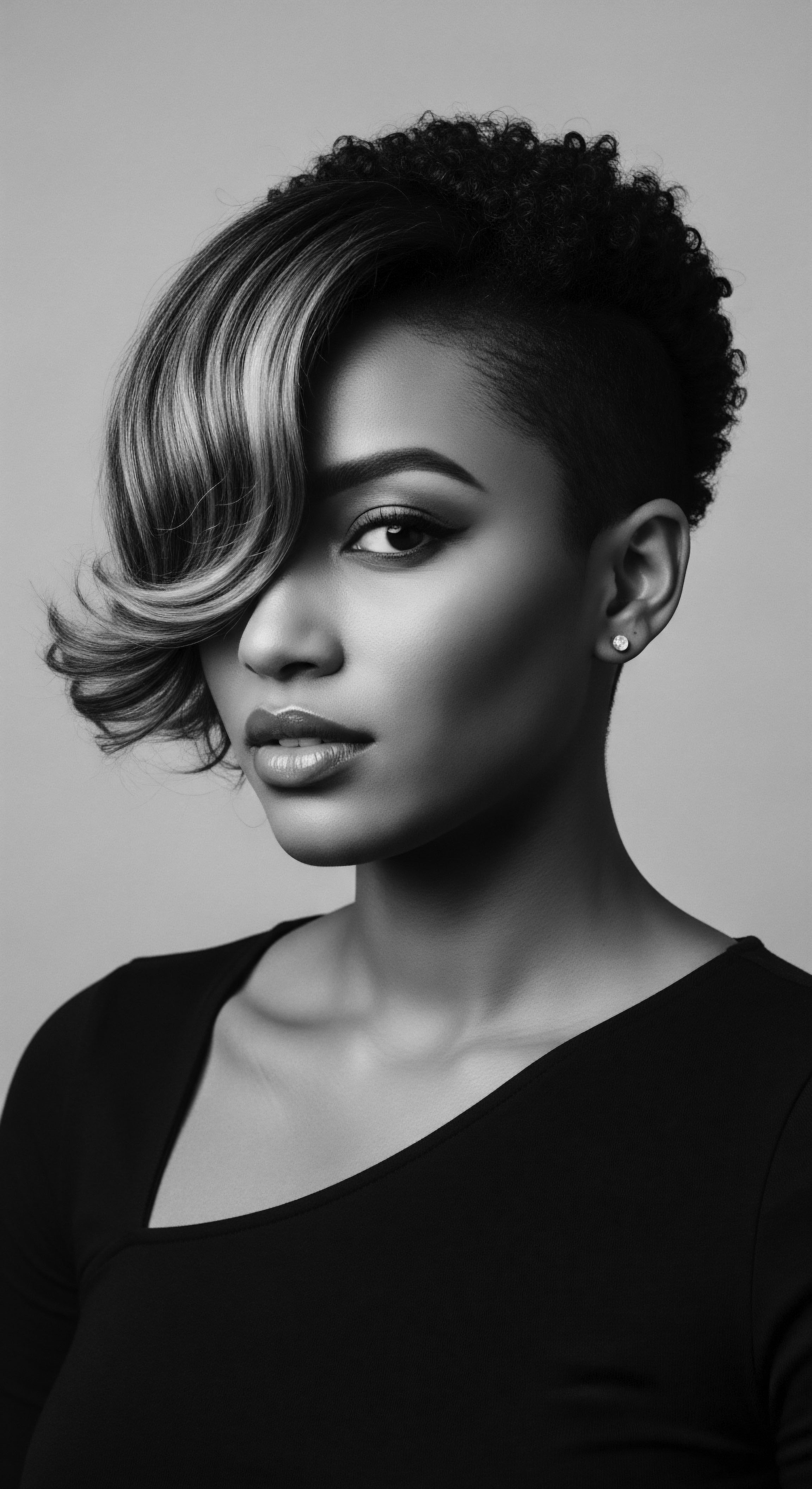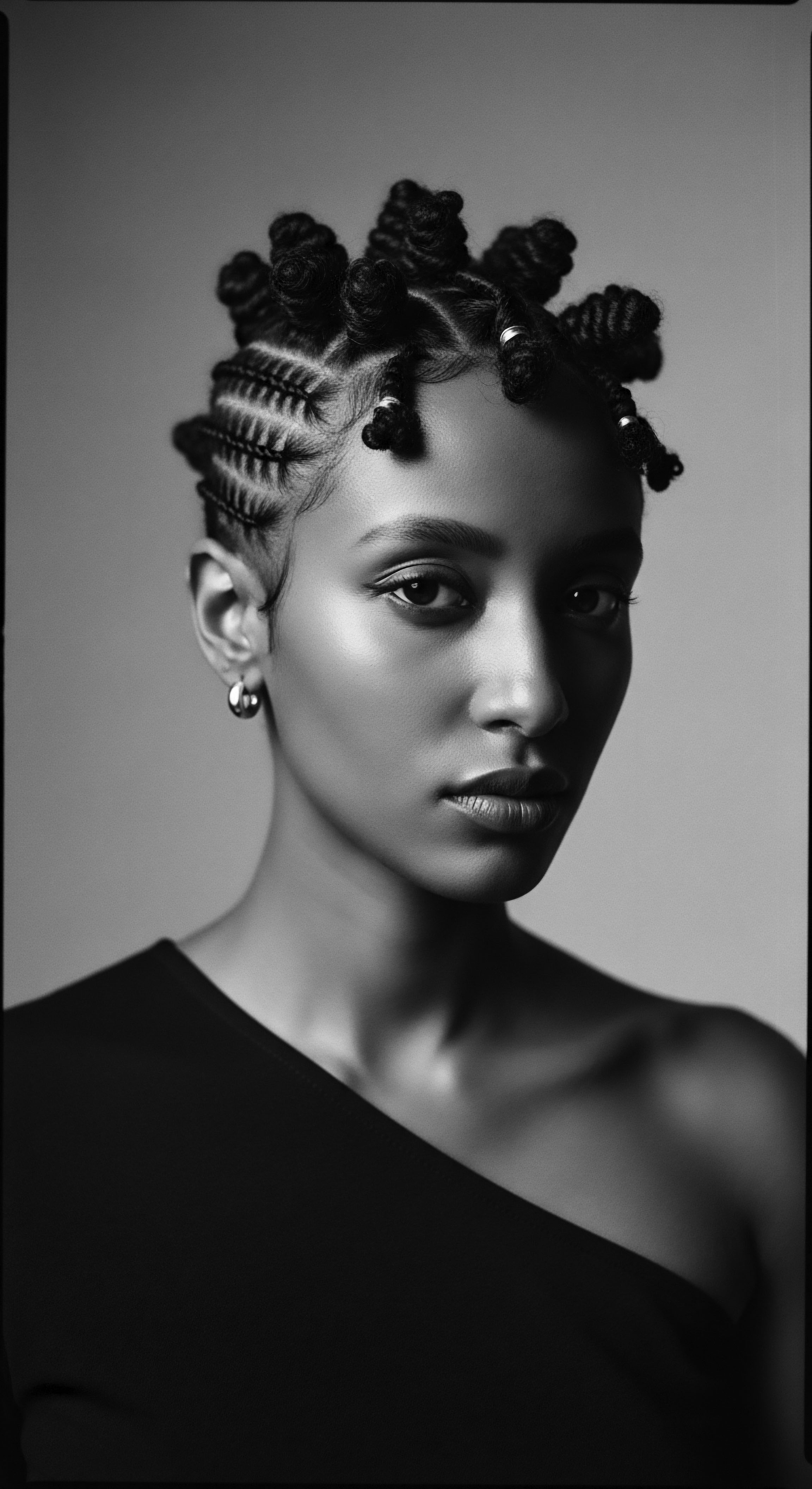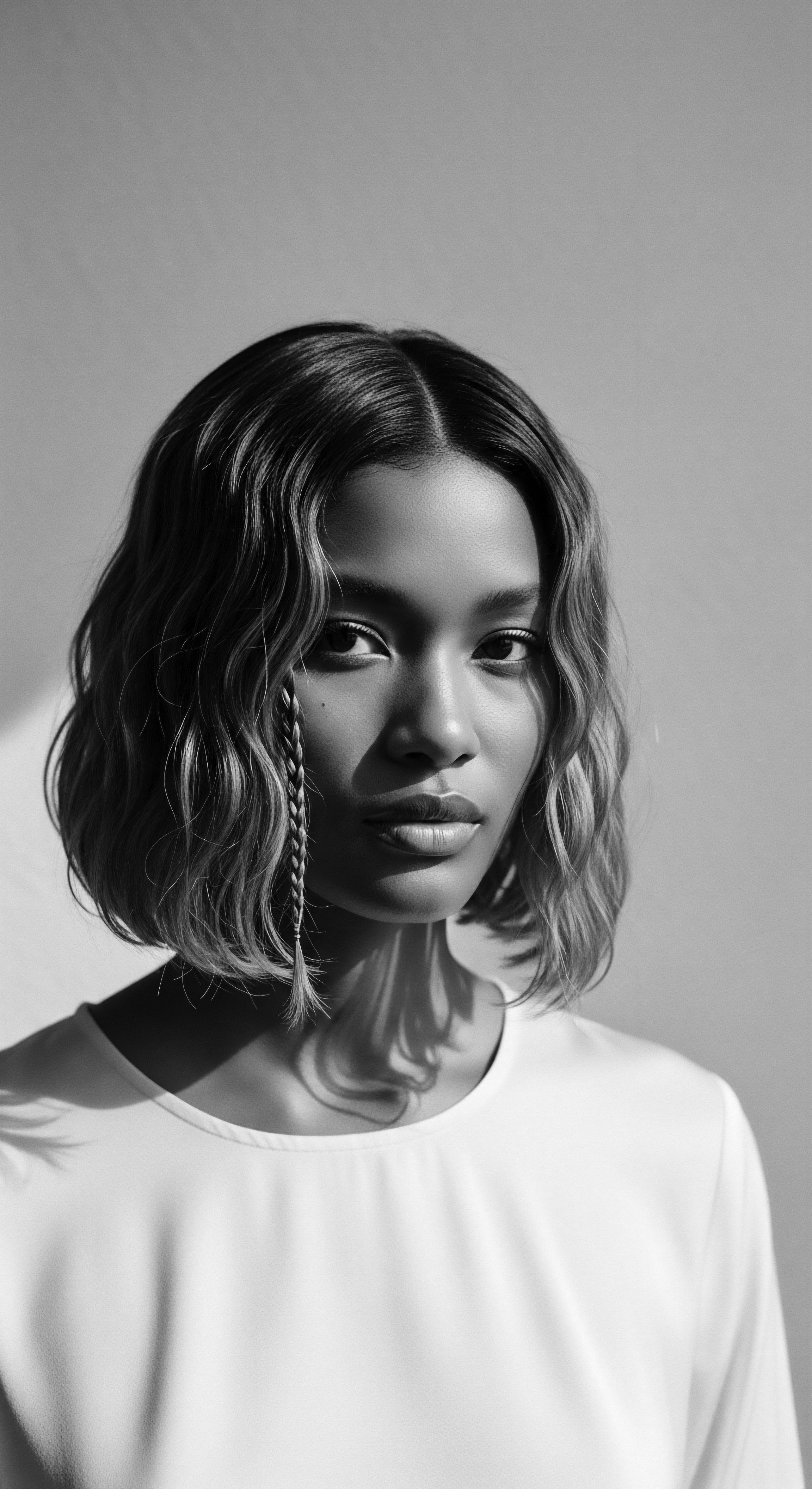
Roots
The story of textured hair, its innate qualities, and the practices that have sustained its vitality extends far beyond fleeting trends or modern scientific discovery. It is a profound chronicle, etched into the very helix of ancestral memory and cultural resilience. For those whose lineage winds through the rich soil of African and diasporic experiences, understanding the historical significance of protective styles in oil retention is not merely a matter of beauty or convenience. It reaches into the heart of identity, a living testament to ingenuity and enduring wisdom.
Consider the unique architecture of textured hair itself. Unlike straight hair, which allows natural scalp oils (sebum) to glide smoothly down the shaft, the distinct coils and bends of curly, coily, and kinky strands create a labyrinthine path. This structure means that sebum often struggles to reach the ends of the hair, leaving it prone to dryness and breakage. This biological reality is not a flaw, but a characteristic that historically prompted, and continues to require, specific, intentional care.
Generations observed this phenomenon, long before the language of lipids and cuticles was formalized. They understood that hair, to thrive, needed its inherent moisture nurtured and secured.
Textured hair, by its very coiled nature, requires intentional care to distribute and seal in vital moisture, a truth understood across generations.

The Hair Follicle and Its Ancient Wisdom
The journey begins at the scalp, a terrain rich with sebaceous glands producing the very oils that hydrate and protect. These oils, naturally expressed, serve as a protective barrier against moisture loss. Ancient peoples, without microscopes or chemical analysis, grasped this elemental truth.
Their methods for hair health were deeply intertwined with practices that respected this delicate balance, intuitively recognizing the need to assist nature’s distribution. We find echoes of this understanding in countless historical accounts, where oils derived from the land played a central role in daily rituals.
The hair follicle’s elliptical or flat shape, which gives rise to tight curls and coils, also creates inherent points of vulnerability where the strand bends. These structural characteristics make textured hair more susceptible to physical stressors and moisture evaporation. Traditional care systems, therefore, often centered on minimizing manipulation and safeguarding the hair from environmental elements, practices now recognized as the very essence of protective styling.

Ancient Classifications and a Living Lexicon
Long before contemporary typing systems emerged, African societies possessed their own intricate ways of classifying hair. These classifications were not just about curl pattern; they were deeply imbued with social, spiritual, and communal significance, often indicating age, marital status, social rank, or even spiritual beliefs. The care rituals, including the application of oils and the creation of protective styles, were an integrated part of these identity markers.
- Dreadlocks ❉ Often associated with spiritual devotion, as seen among the Nazirites of ancient Ethiopia.
- Cornrows ❉ Traced back to 3500 BC in Africa, serving as a visual language to communicate status and escape routes during times of oppression.
- Bantu Knots ❉ A style with deep roots in Southern Africa, offering both protection and a foundation for other styles.
The language of hair care, too, holds ancestral resonance. Terms for specific oils, styling techniques, or tools carried within them generations of accumulated wisdom. While modern terminology provides scientific precision, the historical lexicon speaks to a holistic understanding of hair as a living, sacred part of self, requiring sustenance and safeguarding. This communal knowledge, passed through generations, informed how oils were sourced, prepared, and applied, and how styles were constructed to prolong their efficacy.

Ritual
The historical significance of protective styles in oil retention for textured hair finds its most vibrant expression within the rituals of care and community. These were not mere acts of grooming; they were profound ceremonies of connection, resilience, and identity preservation. Across the vast and diverse landscapes of Africa and throughout the African diaspora, the hands that braided, twisted, and oiled hair became conduits of ancestral wisdom, ensuring hair’s health while also transmitting culture. The very act of styling transformed into a tangible practice of oil retention, shielding delicate strands from the drying sun and wind.

Braids and Coils A Chronicle of Preservation
From the ancient rock paintings depicting cornrows in the Sahara Desert, dating back to 3500 BC, to the intricate patterns worn by Himba women, styles like braids, twists, and locs were chosen for their aesthetic beauty and their profound functional value. These styles, by tucking away the ends of the hair, minimized exposure to harsh elements and daily manipulation. This reduced physical stress on the hair shaft, which is especially prone to breakage at its delicate bends and curves. The hair, once styled, was less subject to the drying effects of direct sun or the tangling caused by movement, effectively creating a micro-environment where applied oils could linger and protect.
Consider the practices of communities where hair styling was an hours-long, communal activity. This extended time allowed for thorough preparation, which included the application of oils directly to the scalp and along the hair strands before they were gathered into protective configurations. This pre-styling oiling was a strategic act, ensuring that the hair was saturated with nourishing emollients that would then be sealed within the protective structure. Such methods not only maintained the hair’s hydration but also allowed natural sebum to travel further down the hair shaft, reinforcing its inherent defenses.
Communal hair styling rituals historically provided the essential time for thorough oil application, securing moisture within protective styles.

Oils From the Earth Ancestral Elixirs
The use of natural oils and butters stands as a constant across African hair care traditions. Shea butter, derived from the nuts of the shea tree, was revered as a sacred ingredient, known for its moisturizing properties. Marula oil, indigenous to Southern Africa, offered antioxidants and essential fatty acids, safeguarding hair from environmental stressors.
Baobab oil, from the revered “Tree of Life,” provided deep hydration and protection. These were not simply cosmetic additions; they were foundational elements of hair health, chosen for their inherent properties that aligned with the needs of textured hair.
The methods of application were often just as vital as the ingredients themselves. Oils were frequently warmed to enhance their penetration, massaged into the scalp to stimulate circulation and encourage sebum production, and then meticulously distributed through each strand. The protective style then acted as a gentle cocoon, allowing these potent botanicals to deeply condition the hair without being immediately exposed to environmental factors that could strip them away. This deliberate layering of oil and style created a sustained release of moisture and nutrients, a practice that scientific understanding now confirms as highly beneficial for moisture retention and scalp health.
| Traditional Oil Shea Butter |
| Ancestral Use for Hair Moisturizing, protecting, used in various cultural beauty rituals. |
| Contemporary Understanding of Benefit Rich in fatty acids and vitamins, excellent for sealing in moisture and softening hair. |
| Traditional Oil Marula Oil |
| Ancestral Use for Hair Used as skin moisturizer, believed to have protective qualities. |
| Contemporary Understanding of Benefit Contains antioxidants and oleic acid, providing environmental protection and light moisture. |
| Traditional Oil Baobab Oil |
| Ancestral Use for Hair Part of holistic beauty, derived from a tree revered for life-sustaining properties. |
| Contemporary Understanding of Benefit High in Omega fatty acids (3, 6, 9) and vitamins A, D, E, K; provides deep hydration and environmental defense. |
| Traditional Oil These ancestral oils, combined with protective styling, represent a historical synergy for textured hair health. |

The Hands That Know Communal Care
The act of styling was rarely a solitary endeavor. It was a communal gathering, a time for sharing stories, wisdom, and nurturing touch. In many West and Central African societies, hair care was so revered that only one or two individuals were designated to care for and dress the hair of others, holding positions of immense respect.
This deep respect for the hair stylist underscored the profound significance of hair care as a cultural institution. It was through these intergenerational exchanges that techniques for intricate styling and the judicious application of oils were passed down.
The practice of hair oiling before braiding or twisting was a fundamental step, ensuring that the hair was supple enough to withstand styling and that moisture was locked in. This attention to detail prevented breakage and minimized the stress on the hair strands, allowing hair to retain its length. This tradition of care was not broken by the horrors of the transatlantic slave trade. Rather, it transformed into an even more powerful act of resistance and survival.
Enslaved African women, stripped of nearly everything, continued to braid rice seeds into their hair as a means for survival and cultural preservation, using their styles to create hidden maps to freedom. This powerful historical example speaks volumes about the enduring heritage of protective styles, not simply as beauty choices, but as tools of life, liberty, and lineage. Even in the direst circumstances, resourcefulness shone through ❉ natural oils like shea butter and coconut oil, or even repurposed animal fats, became precious commodities for hair maintenance, their application often integrated with the styling of protective forms.

Relay
The journey of protective styles and their role in oil retention for textured hair stretches from ancient origins to contemporary understanding, a profound relay of knowledge and adaptation across generations. This section analyzes the complexities of this practice, examining its evolution through societal shifts, the scientific underpinnings that validate ancestral methods, and its enduring presence as a symbol of identity. The insights drawn from historical context offer a deeper appreciation for the ingenuity embedded within Black and mixed-race hair heritage.

Diasporic Journeys Hair as a Vessel of Resilience
The transatlantic slave trade irrevocably altered the landscape of Black existence, but it could not extinguish the flame of hair heritage. Stripped of traditional tools and familiar products, enslaved Africans adapted with ingenuity, using whatever was available to maintain their hair. This resourcefulness included using pig fat, axle oil, or even kerosene in desperate attempts to moisturize hair when traditional resources were unavailable, a stark testament to the relentless human drive for self-care and cultural connection. Despite attempts to dehumanize and control Black bodies through hair alteration, protective styles persisted as a quiet yet powerful act of resistance.
Cornrows, for instance, were not merely a means of keeping hair tidy for arduous labor; they were also reportedly used to conceal rice seeds for cultivation in new lands, or to map escape routes to freedom. This illustrates a dual purpose, deeply practical for survival and profoundly symbolic for cultural continuity.
Post-slavery, as Eurocentric beauty standards gained dominance, hair straightening became a means of survival and acceptance in a hostile world. However, the legacy of protective styles and their moisture-preserving qualities continued in private spaces, within families, passed from elder to youth. The natural hair movement of the 1960s, a powerful expression of “Black is Beautiful,” marked a resurgence of natural styles like the Afro, which openly defied assimilationist pressures and celebrated ancestral aesthetics. This era re-centered hair as a significant aspect of racial pride and collective identity.

Echoes in Modern Science Confirming Ancestral Wisdom
Modern trichology and hair science now offer explanations for the effectiveness of these age-old practices. The unique structure of textured hair—its elliptical follicle, varying keratin distribution, and raised cuticle—contributes to its natural dryness. Sebum, the scalp’s natural oil, does not easily travel down the coiled shaft, leaving the ends particularly vulnerable to dehydration and breakage. Protective styles work by minimizing external stressors and physical manipulation, which are primary causes of hair damage.
When hair is braided, twisted, or tucked away, it experiences less friction, less exposure to environmental drying agents like wind and sun, and less breakage from daily combing and styling. This creates a stable environment that allows natural oils to accumulate and applied moisture to remain sealed within the hair shaft for longer periods.
Modern hair science validates the ancestral understanding that minimizing manipulation and environmental exposure through protective styles supports textured hair’s moisture retention.
Scientific studies highlight the benefits of specific natural oils, many of which were staples in traditional African hair care. For example, coconut oil, rich in lauric acid, has a low molecular weight and a straight linear chain, enabling it to penetrate the hair shaft and reduce protein loss, helping hair retain moisture. Jojoba oil, chemically similar to natural sebum, forms a protective layer, reducing moisture loss. These scientific confirmations reinforce the profound, intuitive wisdom of ancestral hair practices.
For instance, the Basara Tribe of Chad, known for their remarkable hair length, traditionally applies a mixture of herb-infused raw oil and animal fat, often referred to as Chebe, to their hair weekly, braiding it to seal in the treatment. This practice directly illustrates the historical application of oils in conjunction with protective styles to promote length retention by nourishing the hair and preventing breakage.

The Legacy Continues Adapting Traditions Today
The ongoing journey of textured hair care witnesses a dynamic interplay between heritage and innovation. Contemporary hair care recognizes the foundational principles inherited from ancestral practices, adapting them for modern living. This involves using natural oils, selecting low-manipulation styles, and understanding the role of environmental protection. The emphasis on gentle handling and moisture replenishment, cornerstones of historical practices, remains relevant.
Today, accessories like satin bonnets or pillowcases, while seemingly modern, echo the historical use of head wraps and scarves by Black women to protect their hair at night. These practices shield hair from friction, which can strip moisture and cause breakage, effectively prolonging the life of applied oils and natural moisture. The rich history of protective styles, therefore, is not a relic of the past; it is a living, breathing guide for sustaining the health and beauty of textured hair today, a testament to the enduring legacy of ancestral knowledge.

Reflection
The strands of textured hair carry more than just protein and pigment; they hold the very soul of a heritage, a living archive of resilience, ingenuity, and profound cultural memory. The historical significance of protective styles in oil retention is not a mere footnote in beauty history; it stands as a testament to generations who intuitively understood the delicate dance between their unique hair and the world around them. From ancient African villages, where intricate braids conveyed status and spiritual connection, to the silent acts of resistance on plantations, where cornrows hid seeds of survival, the practice of safeguarding textured hair was always deeply entwined with identity.
This journey reveals a continuous thread of wisdom, passed through touch and story, adapting to shifting climates and societal pressures, yet never losing its core purpose ❉ to nurture, to protect, to affirm. The science of today merely offers a language for what was long known through observation and practice ❉ that minimizing manipulation and sealing in moisture are vital for the health and vitality of coils and curls. Our textured hair, therefore, is not only a biological wonder; it is a profound echo from the source, a tender thread connecting us to ancestral practices, and an unbound helix continuously shaping our collective story. It reminds us that care is a form of celebration, and heritage, a timeless wellspring of knowledge.

References
- Byrd, A. D. & Tharps, L. L. (2014). Hair Story ❉ Untangling the Roots of Black Hair in America. St. Martin’s Griffin.
- Davis-Sivasothy, A. (2011). The Science of Black Hair ❉ A Comprehensive Guide to Textured Hair. Sistas with Curlz LLC.
- Majali, M. et al. (2017). African Hair ❉ Culture, Beauty, and Struggle.
- Mbilishaka, K. et al. (2020). Hair Culture and Identity in the African Diaspora.
- Patton, T. O. (2006). Our Own Kind of Beautiful ❉ Black Hair, Culture, and Identity.
- Thompson, E. (2019). Hair and the Black Female Body ❉ Identity, Power, and Resistance.
- Williams, S. (2019). Hair as Heritage ❉ Exploring Black Women’s Hair Journeys.
- Donkor, A. et al. (2014). Antioxidant and Stability of Ascorbic Acid in Baobab Fruit Pulp.
- Komane, B. et al. (2017). Anti-inflammatory Properties of Baobab Oil.
